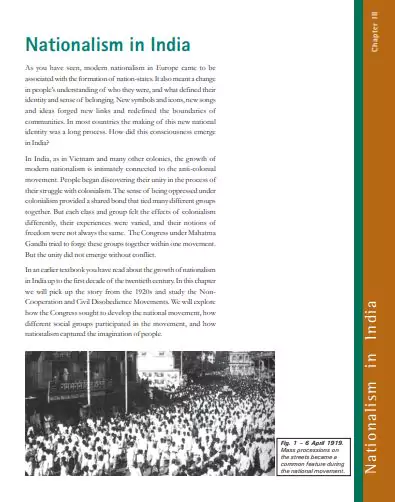‘NCERT Solutions for Class 10 Social Science Chapter 3 Nationalism in India’ PDF Quick download link is given at the bottom of this article. You can see the PDF demo, size of the PDF, page numbers, and direct download Free PDF of ‘Ncert Class 10 Social Science Chapter 3 Exercise Solution’ using the download button.
Nationalism in India Book PDF Free Download

Chapter 3: Nationalism in India
As you have seen, modern nationalism in Europe came to be associated with the formation of nation-states. It also meant a change in people’s understanding of who they were, and what defined their identity and sense of belonging.
New symbols and icons, new songs and ideas forged new links and redefined the boundaries of communities. In most countries, the making of this new national identity was a long process.
How did this consciousness emerge in India? In India, as in Vietnam and many other colonies, the growth of modern nationalism is intimately connected to the anti-colonial movement. People began discovering their unity in the process of their struggle with colonialism.
The sense of being oppressed under colonialism provided a shared bond that tied many different groups together. But each class and group felt the effects of colonialism differently, their experiences were varied, and their notions of freedom were not always the same.
The Congress under Mahatma Gandhi tried to forge these groups together within one movement. But unity did not emerge without conflict. In an earlier textbook, you have read about the growth of nationalism in India up to the first decade of the twentieth century.
In this chapter we will pick up the story from the 1920s and study the NonCooperation and Civil Disobedience Movements. We will explore how Congress sought to develop the national movement, how different social groups participated in the movement, and how nationalism captured the imagination of people.
In the years after 1919, we see the national movement spreading to new areas, incorporating new social groups, and developing new modes of struggle. How do we understand these developments? What implications did they have? First of all, the war created a new economic and political situation.
It led to a huge increase in defense expenditure which was financed by war loans and increasing taxes: customs duties were raised and income tax was introduced.
Through the war years, prices increased – doubling between 1913 and 1918 – leading to extreme hardship for the common people.
Villages were called upon to supply soldiers, and the forced recruitment in rural areas caused widespread anger. Then in 1918-19 and 1920-21, crops failed in many parts of India, resulting in acute shortages of food.
This was accompanied by an influenza epidemic. According to the census of 1921, 12 to 13 million people perished as a result of famines and the epidemic. People hoped that their hardships would end after the war was over.
But that did not happen. At this stage, a new leader appeared and suggested a new mode of struggle. the racist regime with a novel method of mass agitation, which he called satyagraha.
The idea of satyagraha emphasized the power of truth and the need to search for truth. It suggested that if the cause was true, if the struggle was against injustice, then the physical force was not necessary to fight the oppressor. Without seeking vengeance or being aggressive, a satyagraha could win the battle through nonviolence.
This could be done by appealing to the conscience of the oppressor. People – including the oppressors – had to be persuaded to see the truth, instead of being forced to accept the truth through the use of violence.
By this struggle, truth was bound to ultimately triumph. Mahatma Gandhi believed that this dharma of non-violence could unite all Indians.
| Author | NCERT |
| Language | English |
| No. of Pages | 22 |
| PDF Size | 1.4 MB |
| Category | Social Science |
| Source/Credits | ncert.nic.in |
NCERT Solutions Class 11 Social Science Chapter 3 Nationalism in India
1. Explain:
a. Why the growth of nationalism in the colonies is linked to an anti-colonial movement.
Answer:
- People began discovering their unity in the process of their struggle with colonialism.
- The sense of being oppressed under colonialism provided a shared bond that tied many different groups together.
- But each class and group felt the effects of colonialism differently. Their experiences were varied and their notions of freedom were not always the same. The Congress under Mahatma Gandhi tried to forge these groups together within one movement. But the unity did not emerge without conflict.
b. How the First World War helped in the growth of the National Movement in India.
Answer:
War created a new political and economic situation.
- Led to a huge increase in defense expenditure which was financed by war loans and increasing taxes: custom duties were increased and income tax was introduced.
- Forced recruitment in villages caused widespread anger.
- Crops failed; this resulted in an acute shortage of food.
- 12 to 13 million people died due to famines and epidemics.
c. Why Indians were outraged by the Rowlatt Act.
Answer:
- Rowlatt Act was introduced in 1919.
- This act was hurriedly passed through the Imperial Legislative Council, although it was completely opposed by Indian members.
- It had given the Government enormous powers to repress political activities.
- It allowed detention of political prisoners without trial for two years.
d. Why Gandhiji decided to withdraw the Non-Cooperation Movement.
Answer:
In February 1922, Mahatma Gandhi decided to withdraw the Non-Cooperation Movement. He felt the movement was turning violent in many places, and satyagrahis needed to be properly trained before they would be ready for mass struggles.
NCERT Class 11 Social Science Textbook Chapter 3 With Answer PDF Free Download
